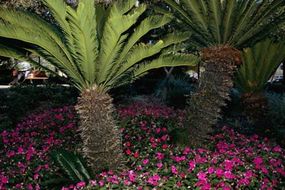Principles of Xeriscaping: Soil, Water, Mulch, Maintenance
Soil improvement
Although plant selection is important, many people aren't aware of how necessary proper soil preparation is to a Xeriscaping project. The right kind of soil will keep plants cool, refrain from evaporating water and retain any excess moisture.
There are three basic types of soil -- sand, silt and clay. Most soil is a combination of the three, but silt works the best for a Xeriscaped garden. Sand allows too much drainage to slip through, while clay retains moisture for too long.
Advertisement
Watering
It's important to know how much water is needed for plants. Some plants can rely on the limited rainwater a region might receive during a drought, but many still need water maintenance, even if it's just a little. Even during the initial stages of conversion, plants may need just as much water as a regular landscape while they establish a root system.
Carefully monitoring your plants can help you determine how much water they’ll need. When plants get thirsty, their roots will shrink up to look for moisture. Although they're trying to feed themselves when this happens, they're also making their root foundation in the ground much weaker. You can usually tell a plant needs more water when it appears to be holding on a little too loosely in the ground.
You can provide plants with efficient irrigation with either a hose-end sprinkler or automatic sprinkler systems. It's important to keep water as low to the ground as possible to avoid spreading it toward unnecessary locations and causing evaporation. There are also drip, micro-spray and bubbler systems that work best for flower beds and shrubs.
Use of mulch
Important for keeping roots cool and minimizing water evaporation, mulch is available in two types -- organic and inorganic. Organic mulch is wood-based, including bark mulch, cedar mulch and pine peelings. Although this type needs to be replaced regularly to keep away rot, wood-based mulch keeps landscapes cool and adds good, complementary color. Inorganic mulch, on the other hand, is stone-based, such as cobblestone or lava rock. Stones don't need to be replaced, but they work best in the shade, since otherwise they'll soak up any heat from the sun and evaporate much-needed moisture.

Maintenance
After everything is planned, prepared and planted, keeping up the landscape is the final step. Fortunately, Xeriscaping makes this easier -- it takes less water to keep plants alive, and any foliage is usually slow-growing. Typical plant grooming is recommended. Clear any dead branches or leaves to promote growth, and make sure the roots are strong.
For lots more information on gardening, plants and water, see the next page.
Related HowStuffWorks Articles
- What is container gardening?
- How to Design a Garden
- How Water Works
- How the Sun Works
- How the Earth Works
- How Grass Works
- How Oscillating Sprinklers Work
- Can grass seed grow on a lava rock as well as it can grow on soil?
- How can the grass on the greens at a golf course be so perfect?
More Great Links
Sources
- Interviews with Mark Nelson and Darrel McCook of the Piedmont Park Conservancy, March 31, 2008
- O'Brien, Bart. "Xeriscaping: sources of new native ornamental plants." Progress in new crops. Arlington, Va.: ASHA Press, 1996. http://www.hort.purdue.edu/newcrop/proceedings1996/V3-536.html
- Wade, Gary et al. "Xeriscape: a guide to developing a water-wise landscape." Colleges of Agricultural and Environmental Sciences and Family and Consumer Sciences: University of Georgia. March 2008. http://pubs.caes.uga.edu/caespubs/pubcd/B1073.htm
- "Water supply and use in the United States." U.S. Environmental Protection Agency. Jan. 25, 2008. http://www.epa.gov/watersense/pubs/supply.htm
- "What is Xeriscape?" Colorado WaterWise Council. 2005. http://www.xeriscape.org/whatis.html
- "Xeriscape principles." Denver Water. http://www.denverwater.org/cons_xeriscape/xeriscape/xeriscapeprinciples.html
- "Xeriscaping: a water-conserving alternative for attractive exterior space planning." ToolBase Services. 2008. http://www.toolbase.org/TechInventory/TechDetails.aspx?ContentDetailI D=929
